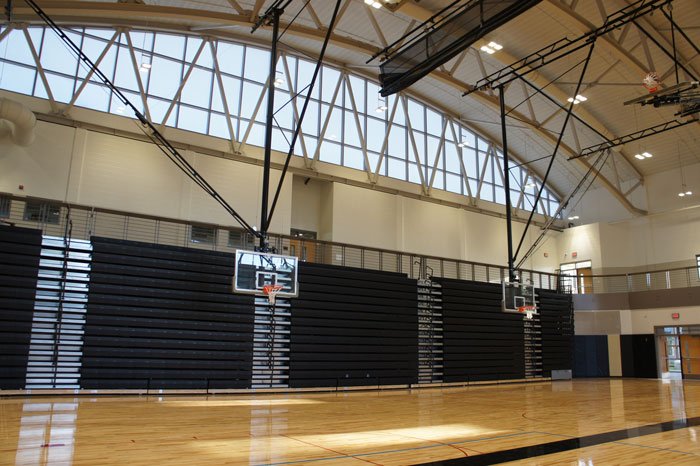Gymnasiums are truly multipurpose spaces, hosting sporting events and practices, physical education programs and pickup games. But they’re also utilized for band concerts, pep rallies, graduations, theatrical performances and more. And whether that gym resides in a university, grade school, rec center or YMCA, there are many equipment choices to consider, depending on a venue’s offerings and programming.
Basketball systems are likely the most ubiquitous gym equipment, with many options to consider, depending on budgets, building characteristics, user base and more. “Stationary wall mounts are the strongest configuration due to the wall and goal connection point,” said Lilly Chidester, marketing and sales worker with a Noblesville, Ind.-based gym equipment manufacturer. “These can handle the load of heavy play.”
Side-fold mounts allow structures to fold horizontally, while fold-up mounts allow structures to move vertically. “Once installed, retracting ceiling-suspended and wall-suspended equipment to get it out of the way for other activities is easy, most often with an electric hoist and key switch or control panel,” said Nick Cusick, founder and CEO of a Lincoln, Neb.-based manufacturer of gym equipment. Some systems move manually with a handle or crank.
“The ceiling-mounted systems are offered in both single and dual post options,” said Chidester. “They are designed for optimal backboard strength and performance and can be customized to facility design. They provide maximum stability with maximum clearance over the court.”
She said for “pay to play” facilities, height adjustment is critical to allow all ages to play. “We have these in different operation styles and for most of our backboard structures.”
“42-inch by 72-inch glass backboards are by far the preferred choice for most facilities, including schools, especially on the main court indoors,” said Cusick. “Occasionally in elementary schools and other pre-high school facilities, side court basketball systems (are) fiberglass or aluminum for cost considerations.” He added that aluminum, steel, fiberglass and unbreakable polycarbonate backboards are most popular for outdoor use.

If a facility hosts competitive sports overseen by a sanctioning body, it’s important to consider their equipment standards. For instance, “both the NFHS and NCAA rely on their rules book for equipment specifications, so there is no testing or formal approval process,” said Cusick. In other words, while they “do set standards about board size and such, they don’t have a testing arm that certifies you like FIBA (International Basketball Federation),” said Chidester.
Portable basketball systems are another option. And while permanent systems far outweigh portable use in schools and recreation centers, according to Cusick, especially in new construction, “portables find their niche in large facilities with multiple courts, in buildings where wall or ceiling construction will not support attached basketball systems without major structural upgrades, and when a facility wants maximum facility flexibility including use of portables in multiple locations.
“Most portables are shipped 70% to 80% preassembled, so onsite installation and placement is significantly easier than mounting equipment to ceiling or wall structures,” he continued. “Moving portables to a storage area when not in use is also relatively easy, but not as easy as raising and lowering attached equipment.”
Added Chidester, “The portable system is ideal for courtside practice, recreational use and play for all ages. They are sized to fit through any standard double door, for easy portability and storage. These are not recommended for main court use or dunking.”
When it comes to volleyball, Chidester said that floor-mounted systems “provide strength and durability for competitive play.”
Featuring posts that fit in sleeves embedded in the floor, these “make up 90%-plus of all volleyball system sales,” according to Cusick. Multiple price points and materials are available, depending on budgets and level of play. “Steel posts are generally the stiffest, but also the heaviest to set up and store. Aluminum is lightweight, but most aluminum systems have more flex that impacts net tensioning.”
And while carbon fiber poles are more expensive, they’re “a good balance between weight and rigidity and are gaining in popularity.”
Ceiling-hung systems are also available and can be manufactured to meet specific facility requirements. “Ceiling-hung systems allow users to easily raise and lower the unit with the flip of a switch, making it perfect for multi-sport courts,” said Chidester. “They also eliminate the need for transporting heavy uprights and save storage space.”
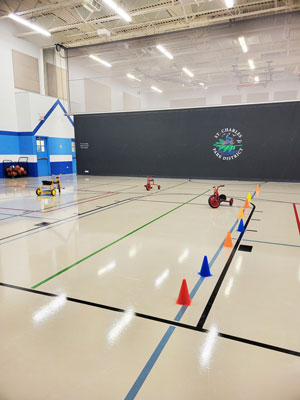
She said multi-sport net systems are popular in rec facilities and elementary schools. “They allow for volleyball, badminton, pickleball and tennis to be played in a non-competition setting.”
Cusick pointed out that pickleball is a fast-growing sport, “not only for aging tennis players but for school-age and competition play.”
He agreed that multisport systems—which allow for net height adjustments—are primarily for recreational or P.E. use. “The most common pickleball systems used indoors are portable units that fold up for storage.” And he added that “portable volleyball systems serve a purpose in facilities where installing floor anchors or sockets is impossible or impractical.”
“Portable volleyball systems allow facilities to host competition matches without the hassle of installing floor sleeves,” agreed Chidester. “After the game-winning serve or spike, simply release the brake and roll the system into storage.”
Multi-sport portable bases allow for volleyball, badminton, pickleball, tennis, tetherball, paddle tennis and there’s even a basketball hoop attachment. Additionally, volleyball referee stands are available, including collapsible versions.
In the Chicago suburb of St. Charles, Ill., the Pottawatomie Community Center houses the Conner Gymnasium. And no surprise, pickleball is a popular activity. “We offer drop-in pickleball as well as beginner, intermediate and competitive leagues,” said Lara Piner, supervisor of the community center, adding that they also offer tennis and volleyball. “Our gym is professionally lined for basketball, volleyball and pickleball. Our net system is portable pickleball and tennis nets, and volleyball is portable with the posts in the floor.
“We have six basketball hoops that lower and raise from a winch system in the ceiling,” continued Piner. “The four nets that are on the side walls can be lowered and raised with a crank for different age group play. The two middle nets cannot.”
There are open gym times for middle school, high school and families. Additionally, “We do gym rentals for most groups; private birthday parties, team practices and adult volleyball, basketball and pickleball rentals.” The rentals are all sports-related, otherwise “we only allow our own programs in the gym, such as a daddy-daughter dance.”
In inclement weather, the park district’s summer camp program might also utilize the gym. “The kids play things like soccer, basketball, dodgeball, line tag and kickball,” said Piner. There is also preschool playtime a few days a week for the public, supervised by parents, with scooters, balls, sit n’ rides, adjustable hoops, a small climber and folding chairs provided.
As far as storage, Piner said “We have two gym equipment closets and one rolling basketball cart in the gym.”
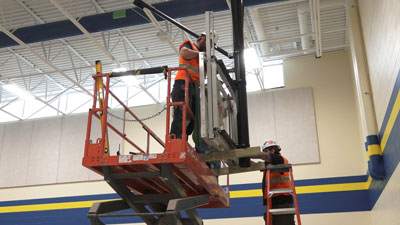
“We do have a gym divider curtain that splits the gym in two,” she added. “It’s mounted from the ceiling and comes down on a motor.” A couple times a week, pickleball courts are broken down from four to two courts, and the preschool programming takes over half of the gym.
In fact, gym divider curtains and multi-sport cages are common for facilities looking for extra flexibility. “Both the curtains and cages are ceiling suspended so they can be easily lifted to maximize gym space,” said Chidester. “Dividers allow gyms to divide spaces to have multiple sports and activities going on at once.”
Cusick pointed out that while many facilities have ceiling-suspended divider curtains, “Portable divider nets are less costly, easy to install and can serve the same purpose for many facilities at a lower cost.”
Safety padding is a key gym component, according to Cusick. “While NCAA, NFHS and international rules call for padding of many types of equipment, there are many other safety padding options on walls, beams, stages and other surfaces that should be considered even though there is no published rule.”
Chidester said their padding is offered in different materials, “depending on the aggressiveness of play. We have polyurethane, foam and neoprene pads. We also offer them in 14 color selections.”
Back in St. Charles, Scott Nold teaches P.E. and is the athletic director at Wredling Middle School, which has around 1,400 students. He said their competitive sports teams—and sometimes the cheerleaders—use the same gym as their P.E. classes. “Our athletic teams use different equipment than the P.E. classes. The gym is also used for band, choir and orchestra concerts and (by) other outside sports teams that rent the facility.”
Nold said they utilize lots of different P.E. equipment, including badminton and pickleball racquets, soccer balls, footballs/flag belts, gator balls, basketballs, softballs, kick balls, volleyballs, bats, bases, goals, nine square in the air, gaga ball pits and floor hockey sticks. “We have a P.A. system that’s Bluetooth in our main gym and microphones.”
He said their basketball systems are ceiling-mounted, raising and lowering by “pushing a code and a button. All six in our main gym can go up and down simultaneously; in our small gym they go up and down individually.
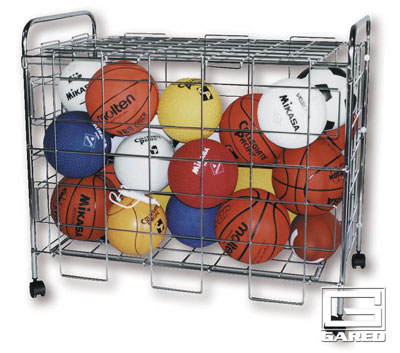
“Our volleyball system goes into the floor sleeves,” he continued. “We lift the caps off the floor and mount the system.” He said they also use portable volleyball poles—separate from their athletic system—in order to play pickleball during P.E. “We set the net lower with bungee cords. We also use the portable volleyball poles for volleyball and badminton activities.”
They have ceiling-mounted gym dividers in each gym, and “we have a portable volleyball official’s stand, a scorer’s table that fits in the bleachers and our team bench is on the bleachers inside.”
He said they have different store rooms for athletics and P.E. “In each of those rooms we have shelving and ball carts for all types of balls. Racquets go in bins that we have on the shelves. Our gaga ball pit goes on a rack and our nine square is bagged.”
Wredling has a competitive wrestling team, and Nold said they have two full-size wrestling mats. “One is the old-school three-section mat and the other is a seven-section lightweight Velcro model.” And while the cheerleaders have a separate nine-section mat, they might use the wrestling mats for warm-ups at events. “All the mats have been reconditioned at some point, but that’s like every five to 10 years. We have had to glue the Velcro back to our wrestling mats, but that can be done by us.”
Mats gobble up space, and Chidester said they have a variety of ceiling-hung mat storage systems. “We also have a forward-moving mat carrier system that lifts mats to ceiling level and uses a motorized trolley system to move it to a secondary location.”
Indeed, with storage space at a premium, Cusick said that “Ball carts, volleyball post storage carts and other equipment carts can not only make storage easy, but reduce damage and lost equipment.”
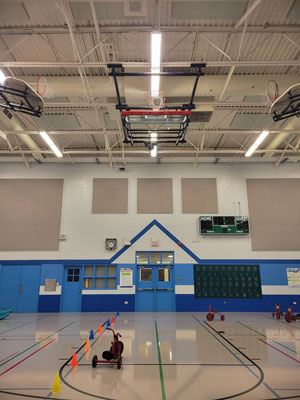
Technology also plays a role, such as gym control systems, which enable one-touch operation of basketball backstops, divider curtains, lighting, scoreboards, PA systems or other electrically controlled equipment. Chidester said these allow for “quick and easy transition between systems, with features like ‘Game Day’ that allows side courts to raise and main courts to lower at the same time with the press of a button.”
Maintaining gymnasium equipment must be considered, and Chidester said they have a program that “educates and assists our vast dealer network on when and how to do preventive maintenance on our equipment. There are levels to the program, and some are for the end-users as well, to perform visual maintenance.”
“Our baskets are maintained at least once a year,” said Nold, who mentioned that a company had recently come in to “inspect both the bleachers and baskets to make sure they were in working order.”
Piner said “We maintain our own gym floor with daily dust mopping and spot cleaning, weekly auto-scrubbing and yearly striping and resealing. Our gym curtain maintenance is via the vendor and we typically maintain our own gym hoops and smaller equipment.”
“Maintenance of all equipment is key to safety, function and long life,” said Cusick. “Much like taking care of your house, regular inspection for loose bolts, missing parts and other deficiencies—especially prior to the beginning of the season—is important. A stitch in time saves nine.” RM



